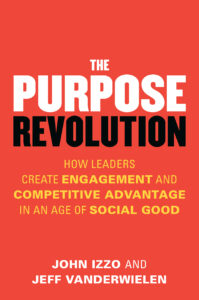How Leaders Create Engagement
A decent product at a fair price with good customer service may once have been enough. No longer. The bar has moved. Employees and customers want organizations to do some social good along the way.
My friend and bestselling author John Izzo is out with a new book, co-authored by Jeff Vanderwielen: The Purpose Revolution: How Leaders Create Engagement and Competitive Advantage in an Age of Social Good. The book is full of examples and ideas to help you move your organization to one that is infused with purpose.
I recently asked John to share more about his research and work in this area.
4 Forces Driving Change
You say that there is a revolution happening right now and ignoring it will send your company to irrelevance. What is it and what forces are driving it?
The revolution is a desire among employees, customers and investors to leverage social good with their choices. This is a revolution of AND not OR. Employees want everything they have always wanted, but they also want a job that gives them a sense of purpose in a company they feel is doing good in the world. Customers want products that excite them at a good price, but they also want to leverage good with those choices—and certainly buy things that cause no harm. Investors was a return on money, but the fastest growing funds are those that also promise social impact.
In an age of commoditization, the marketplace is filled with many similar products, and purpose is a way for companies to create brand differentiation based on values, not just product.
What’s driving the revolution are four primary trends. The Millennials are now a global force with a strong set of values around creating social good and having meaning in their work. The boomers are moving into the “legacy” stage of life where the impact they leave starts to compete with ego. The rising middle class in the developing world is another major driver, as people rise out of poverty, they are able to think about the social good in their choices. Finally, business is both blamed for some of the world’s biggest challenges but also increasingly seen as the key to addressing those same issues through corporate social responsibility.
Connect Purpose to Contribution
How do leaders help employees connect purpose to work contribution?
The first step is to have a clearly articulated compelling purpose that is authentic. Starbucks’ purpose is to “inspire the human spirit one cup of coffee at a time” while 3M’s is to “advance every life and improve every business while using science to solve the world’s greatest challenges” (like sustainability).
The second step is to drive job purpose more than job function. Focus on the real impact jobs and teams make. Have every person identify the purpose of their job and the same for every team. Consistently tell stories of how your company makes a real difference. Bring in customers to tell their stories, and create space for employees to do the same. One large bank we worked with started having a standing agenda item in every branch: “How did we make a difference for a client since last time we met?” In the branches that did it, engagement went up 23% and sales went up 18%!
Move Purpose to Center Stage
What are some ways that the leader can find the purpose and “move it to center stage”?
 Most leaders and companies focus on numbers when they need to focus on contribution. Start by making sure you communicate more about purpose than about profit. Make sure the first questions you ask are related to the difference you want to make. For example, at 3M, Inge Thulin makes sure “the first question I ask at any site I visit is, ‘What are you doing about sustainability?’”
Most leaders and companies focus on numbers when they need to focus on contribution. Start by making sure you communicate more about purpose than about profit. Make sure the first questions you ask are related to the difference you want to make. For example, at 3M, Inge Thulin makes sure “the first question I ask at any site I visit is, ‘What are you doing about sustainability?’”
Another way to bring it to center stage is to ensure that your purpose and values are always the screen through which you make decisions. In the book, we call these “moments of purpose congruence.” For example, at Wells Fargo when they decided to open accounts for people who had not chosen to open them, they proved that purpose was not at center stage of their actions. The opposite happened at Whole Foods when they moved purpose to the forefront: they stopped selling any seafood that wasn’t certified as sustainable, even though they lost sales and profitability in the short term. Pay attention to purpose because people are watching what you do, especially your team members.
Another way to put it at center stage is to ensure you feature it in recruiting. Change all job descriptions towards purpose, put purpose in every performance appraisal, like at 3M where sustainability is part of every person’s performance assessment.
Give us an example of a company that is making purpose a competitive advantage.
In the book we feature many companies doing this, but two come to mind right away. Dove and Ben & Jerry’s. Here are two companies that have made a real purpose connection with their customers, on values not just product. Both those companies are growing 35% faster than other brands. At Ben & Jerry’s, about a third of their customers buy from them because of the connection to their stances on issues like climate change. They told us their research shows that when other premium ice creams go on sale, these folks never convert. Purpose gains them a different loyalty. A more traditional example is 3M, whose focus on sustainability is stellar. They tell us that when they go to university campuses, the best and brightest science students line up to try and get a job at 3M. Most of the hard work of recruiting is done through their reputation. When it comes to purpose, talent is the canary in the mine. Companies tell us the top candidates are now choosing companies they believe in, and purpose is more powerful than compensation.
Talk about the connection between brand and purpose.
A brand is the enduring image people have of your company or product. Purpose is a part of your brand but not all of it. You still need to be good at other things. The folks at Seventh Generation said they had a hard time winning customer loyalty when their products didn’t clean as well as their competition even though they were very “green and responsible.” So they had to close that gap, which they did. Suddenly they became a lot more successful. Darren Entwistle, CEO of TELUS, told me that “all things being equal, customers will buy good.” So your brand can’t just be about purpose. But when great ice cream comes together with connecting to people’s values for doing good, that is when the magic happens.
Build a Culture of Purpose
What are some of the best practices you have seen to drive a culture of purpose?
One of the most critical things is to create what we call Line of Sight to Purpose. Over seventy percent of employees say that the company they work for mostly cares about profits, and customers have confidence that only 6% of brands are good, so you have to find ways to consistently highlight your purpose and let people see it. That means telling people your “story of good” right on the label at point of purchase; it means leaders constantly telling real stories of how your company is making a social impact, and it means working hard to ensure your internal team believes in your purpose.
You should measure whether your employees believe in your purpose (and think it is lived), because while people only believe 16% of what a company says about itself, over 60% say they believe what an employee says about a company. So one of the best practices is to work even harder to communicate your story of purpose inside than you do outside. Westjet in Canada is a great example of a company that has historically worked really hard to ensure their team members believe in their purpose of caring—and then let them be the ambassadors for the brand.
You Can’t Fake Purpose
What are some of the common mistakes leaders make when it comes to leading a Purpose Revolution?
 One of the biggest mistakes is to think that purpose is just a marketing strategy. Purpose has to be an authentic desire to make life better—now and in the future—for customers, employees and society. You can’t fake purpose. So it has to start inside with leaders truly asking: What do we want our legacy to be? What is the real difference we want to make? We live in an age of authenticity, so you will get outed if it’s not real.
One of the biggest mistakes is to think that purpose is just a marketing strategy. Purpose has to be an authentic desire to make life better—now and in the future—for customers, employees and society. You can’t fake purpose. So it has to start inside with leaders truly asking: What do we want our legacy to be? What is the real difference we want to make? We live in an age of authenticity, so you will get outed if it’s not real.
Purpose must be an authentic expression of your values and desire to add value. It is not just something you do because you heard people want it. A great example for me is when Pepsi ran an ad in the midst of the Black Lives Matter conversation with a celebrity ending a riot by giving a policeman a Pepsi. It was a clear attempt to be relevant in the moment, but it didn’t have lasting impact. Compare that with Tecate in Mexico that campaigned against domestic violence in a substantial way and went so far as to say if you do violence to women or condone it, we don’t want you to drink our beer. It aligned with other efforts the parent company Heineken Mexico was doing to “Win Big for a Better Mexico,” which is their stated purpose. Winning in the purpose revolution requires authenticity. You can’t fake this stuff.

